IS Audit Report Template
The template that begins on page 2 of this document is to be used in developing an IS audit report.
Several factors impact the content and length of the report, such as:
Type of audit
Complexity of entity operations and systems
Number of audit objectives and audit findings
Different readership categories
Details needed to make the content understandable
Disclosures
Required supplemental information
For example, reports that are made available to the public are likely to contain more explanatory
material than internal audit reports that are submitted solely to auditee management within an
organisation.
NOTES:
1. This template includes recommended standard language and identifies areas where audit-
specific information should be included. For additional guidance, see the section on audit
report content.
2. The text in green/italics format indicates template instructions that should be replaced with
relevant text.
© 2015 ISACA
All rights reserved.
1
�
INDEPENDENT
AUDITOR’S REPORT
[Insert name of the audit
organisation]
[Insert name of the auditee
organisation]
[Insert start date to end date of the
audit period covered by the audit]
© 2015 ISACA
All rights reserved.
2
�
[Insert date of audit report issuance]
[Insert name of auditee organisation]
[Insert address and country of auditee organisation]
We are presenting the results of our IT audit [insert audit title] covering the period of [insert start date
to end date of the audit period]. The report includes our conclusions and/or opinion regarding the [insert
abbreviated statement of scope] and [summarised statement of audit objective(s)]. The audit was
conducted in accordance with the IS Audit and Assurance Standards and IS Audit and Assurance
Guidelines issued by ISACA and [insert any additional auditing standards relevant to the audit]. We
believe that the evidence obtained provides a reasonable basis for our conclusions and findings
regarding the audit objectives.
[Insert signature of chief auditor or signed name of the audit organisation including location]
© 2015 ISACA
All rights reserved.
3
�
TABLE OF CONTENTS
Section
Page
Introduction......................................................................................................
Executive Summary...........................................................................................
Audit Scope.......................................................................................................
Audit Objectives................................................................................................
Methodology.....................................................................................................
Audit Results or Audit Findings.........................................................................
1....[Name of audit area for finding number]............................................
2....[Name of audit area for finding number]............................................
3....[Name of audit area for finding number]............................................
Audit Conclusions (or Opinion).........................................................................
Appendices (by example)..................................................................................
© 2015 ISACA
All rights reserved.
4
�
INTRODUCTION
[An introduction typically includes the following details:]
Description of the business
[Typically includes a high-level description of the business organisation, which includes its mission,
primary business objectives, customer/client base, and location (worldwide provider of X headquartered
in Y).]
High-level description of the applicable IT infrastructure
[Typically includes a high-level description of the IT infrastructure applicable to the audit.]
High-level statement of purpose
[Typically includes a high-level statement of the purpose of the audit to support the understanding of
external readers of the report. For example, for a general controls audit you can state “Our audit focused
on an examination of certain IT general controls over and within the [insert name of auditee entity]
business operations and/or IT environment.]
IT area that is the subject of the audit
[Identify the IT area (function, system, project or other) that is the subject of the audit).]
© 2015 ISACA
All rights reserved.
5
�
EXECUTIVE SUMMARY
[High-level description of the primary message of the report]
[Key audit objectives]
[Summary of audit results]
© 2015 ISACA
All rights reserved.
6
�
AUDIT SCOPE
In accordance with [insert source of audit authority, such as audit charter, law or contract agreement],
we performed an audit of [insert primary topic area of audit scope] at the [insert name of auditee
organisation], for the period of [insert start date to end date of the audit period covered by the audit].
The scope of our audit consisted of an evaluation of [insert IS audit area, such as function, system, IS or
business project].
The audit was conducted in accordance with the IS Audit and Assurance Standards and IS Audit and
Assurance Guidelines issued by ISACA [insert other applicable standards and guidelines]. Those
standards require that the audit be planned and performed to obtain sufficient, relevant and valid
evidence to provide a reasonable basis for the conclusions, opinions and audit findings (if any).
[If the auditee is likely to expect reviews or examinations that are not included under the scope of the
engagement, the audit scope section should identify the limitations. An example is, ‘Our scope was
limited to an examination of controls regarding physical security and disaster recovery testing’.]
© 2015 ISACA
All rights reserved.
7
�
AUDIT OBJECTIVES
Our audit objective was to determine whether adequate controls were in place and in effect to provide
reasonable assurance that [insert statement of what is to be attained through the use of controls]. [For
example, ‘Our audit objective was to determine whether adequate controls were in place and in effect
to provide reasonable assurance that only authorised users could access the (insert name of IS system)’.].
[Because this section may include more than one audit objective, objectives should be presented in a
logical order in terms of importance and whether more-specific objectives come under overarching audit
objectives. For internal control examinations and performance audits, statements of audit objectives
should be directly tied to the related control or operational objectives. In addition, audit objectives
should use language such as ‘To determine whether, to assess or to evaluate’ and not use language such
as ‘The purpose of the audit is to ensure that adequate controls . . .’ because that is auditee
responsibility.]
[If it is an internal control examination, include a statement that professionals have conducted the audit
engagement to express an opinion on the effectiveness of control procedures.]
[The maintenance of an effective internal control structure, including control procedures for the area of
activity, is the responsibility of management.]
© 2015 ISACA
All rights reserved.
8
�
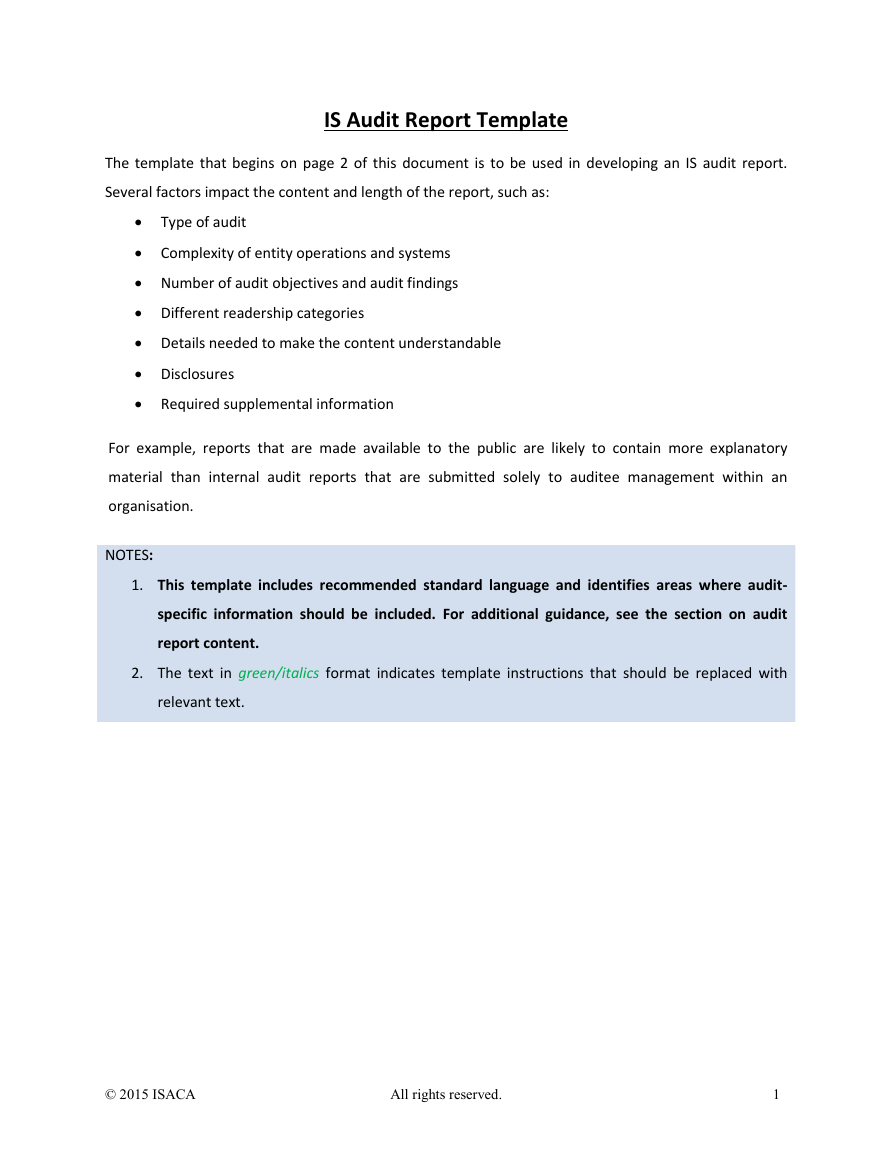
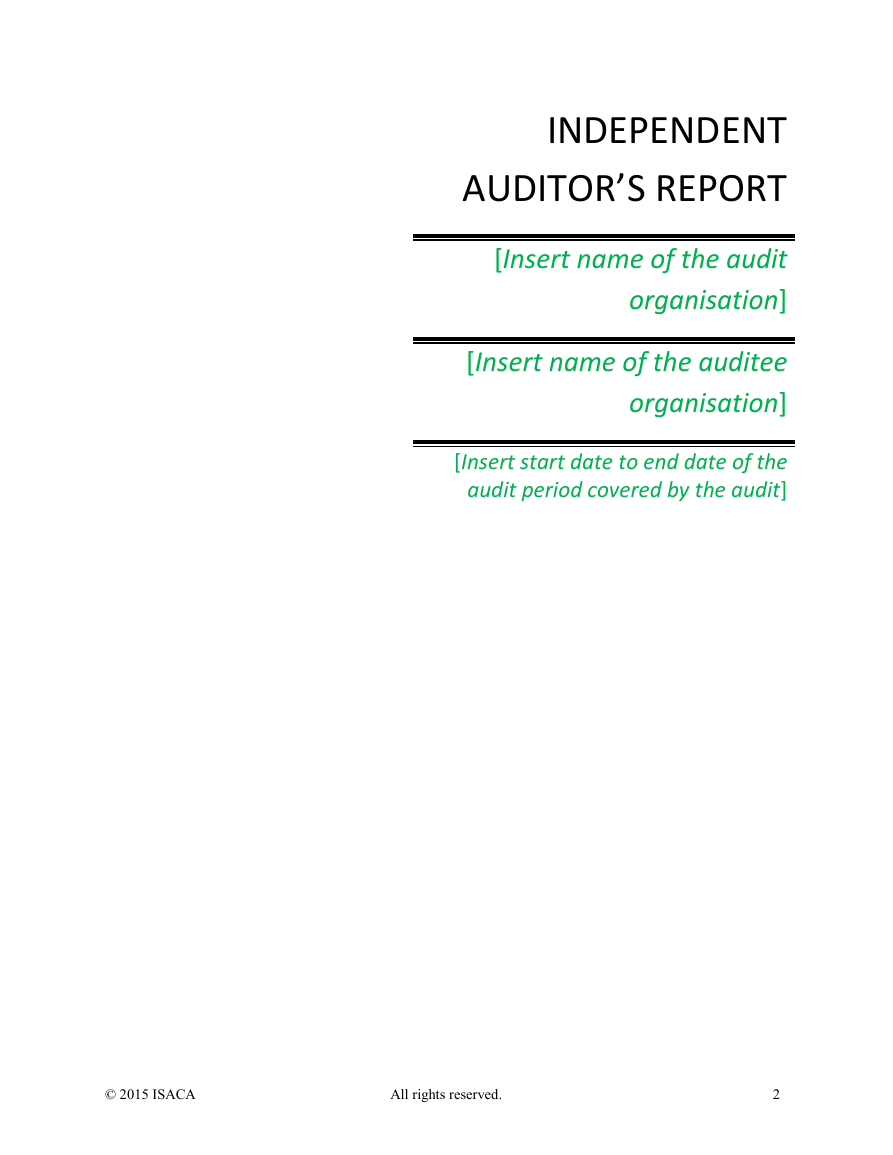
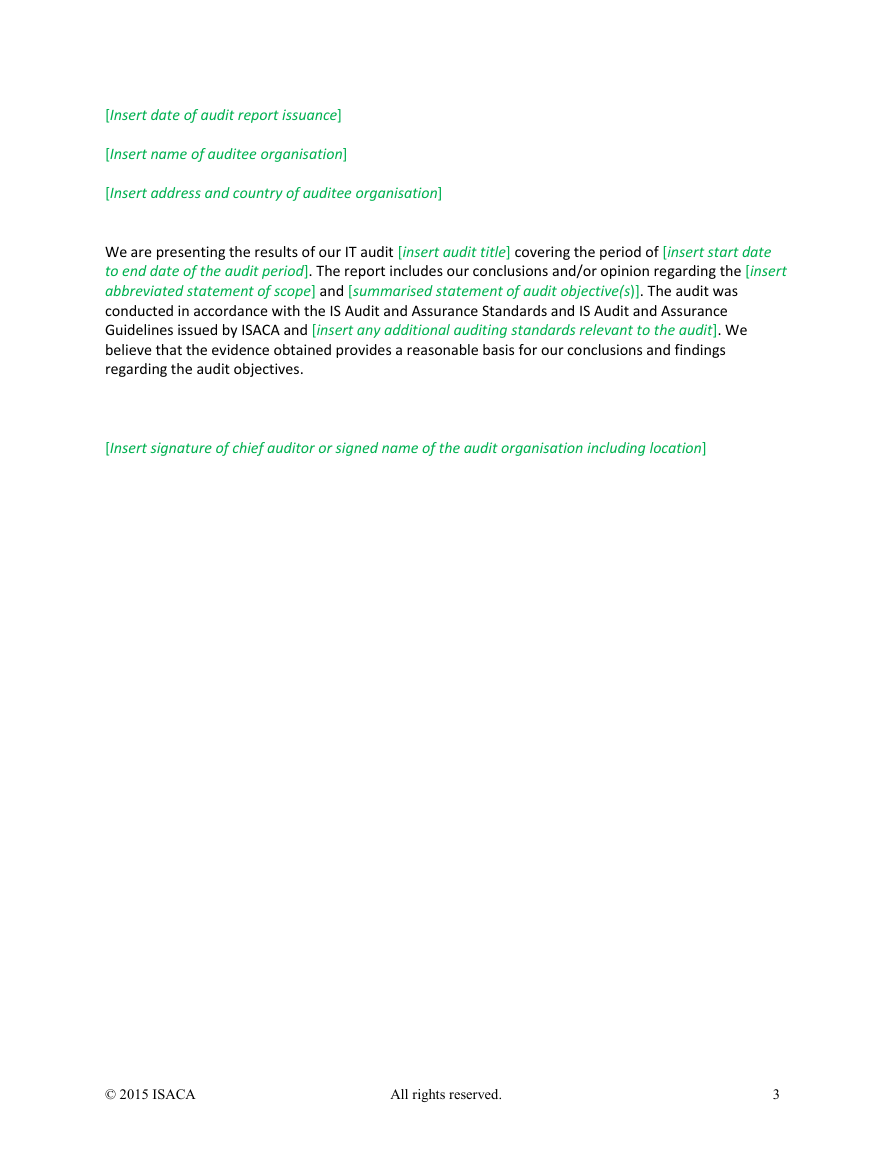
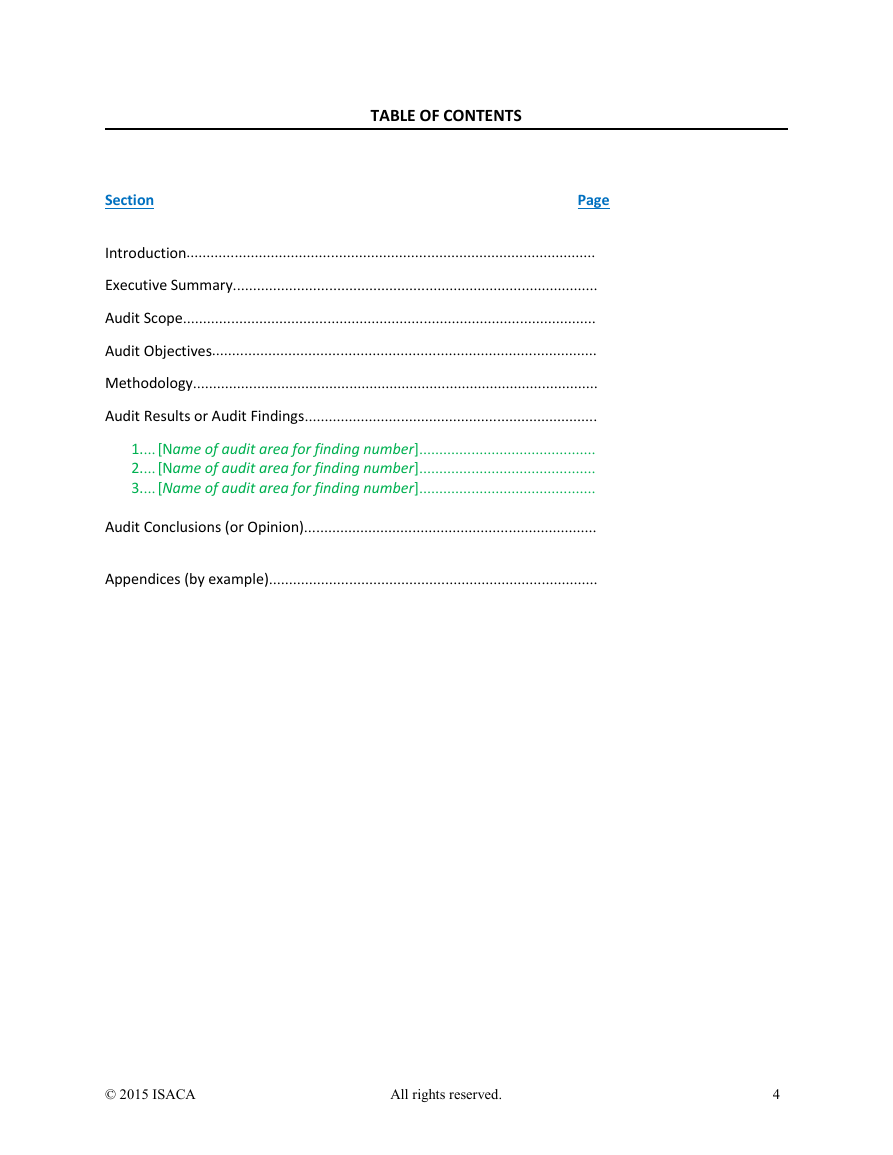

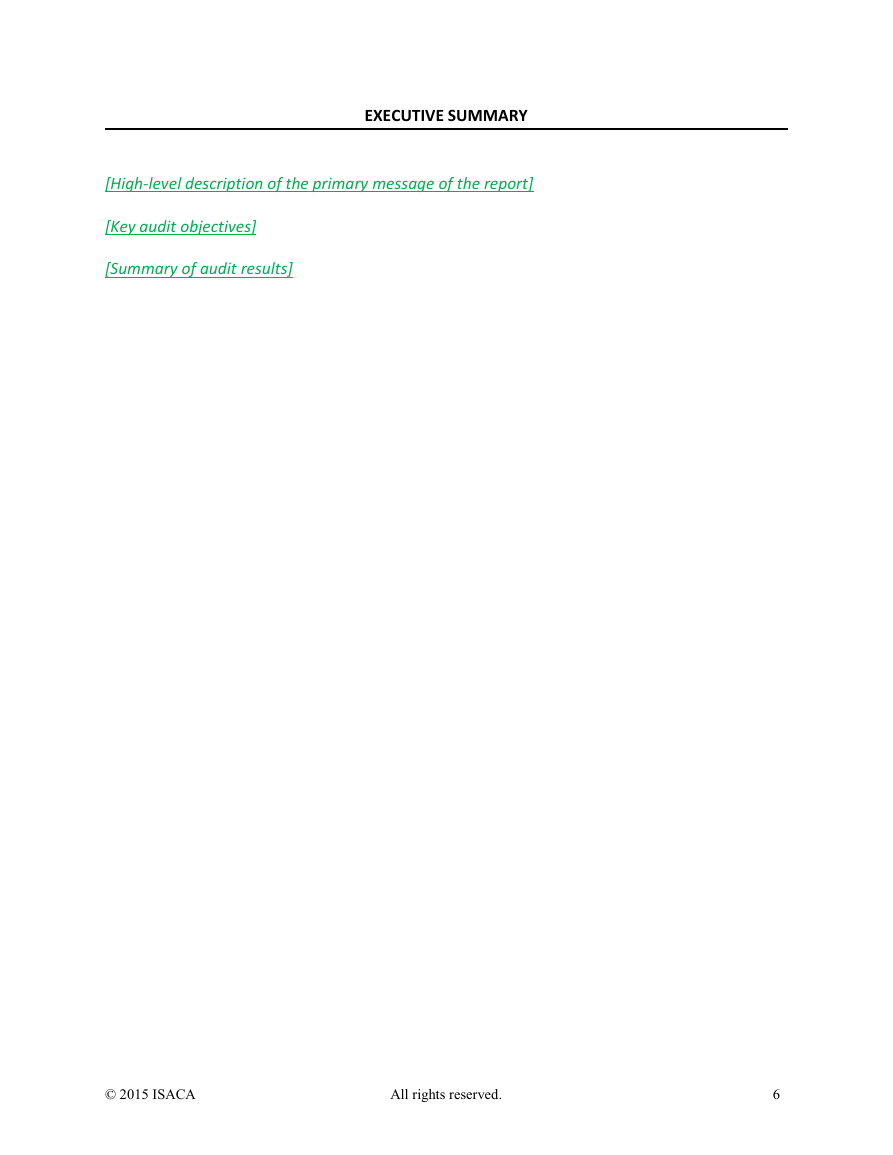
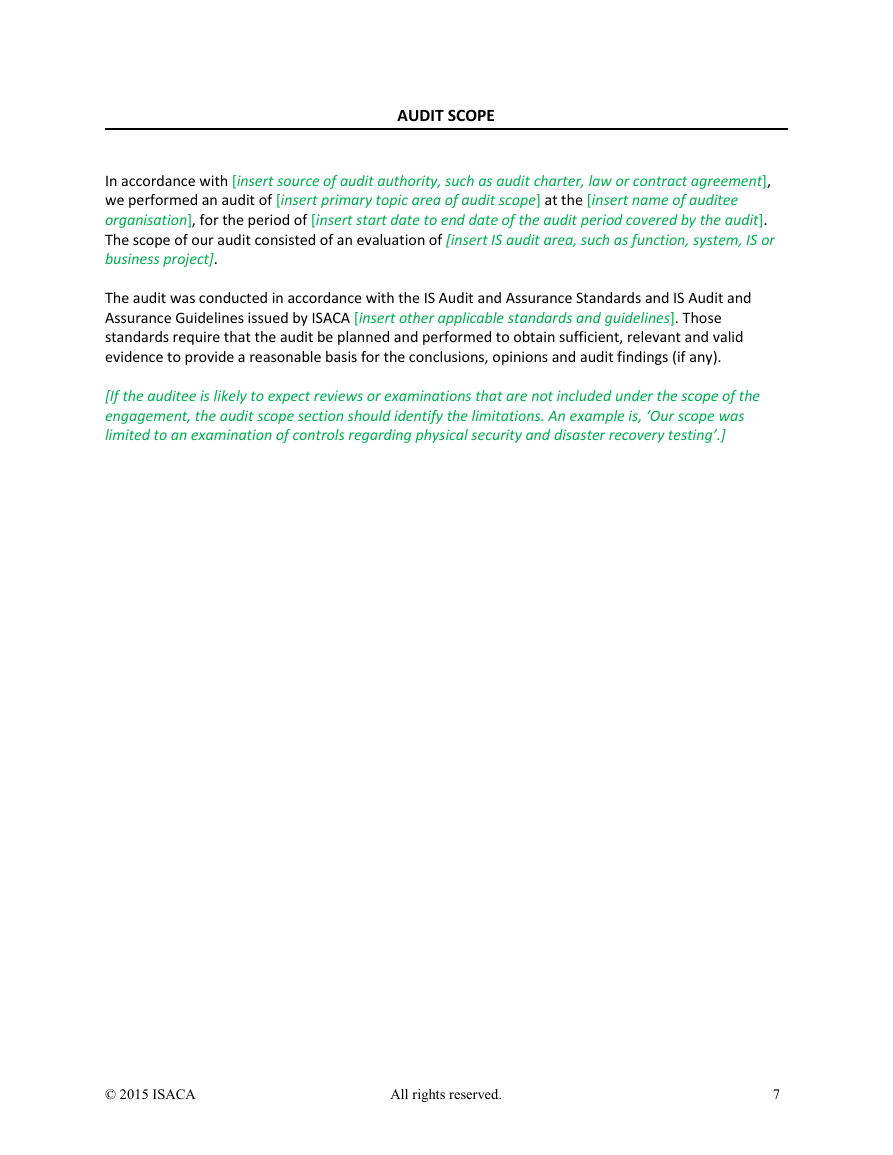
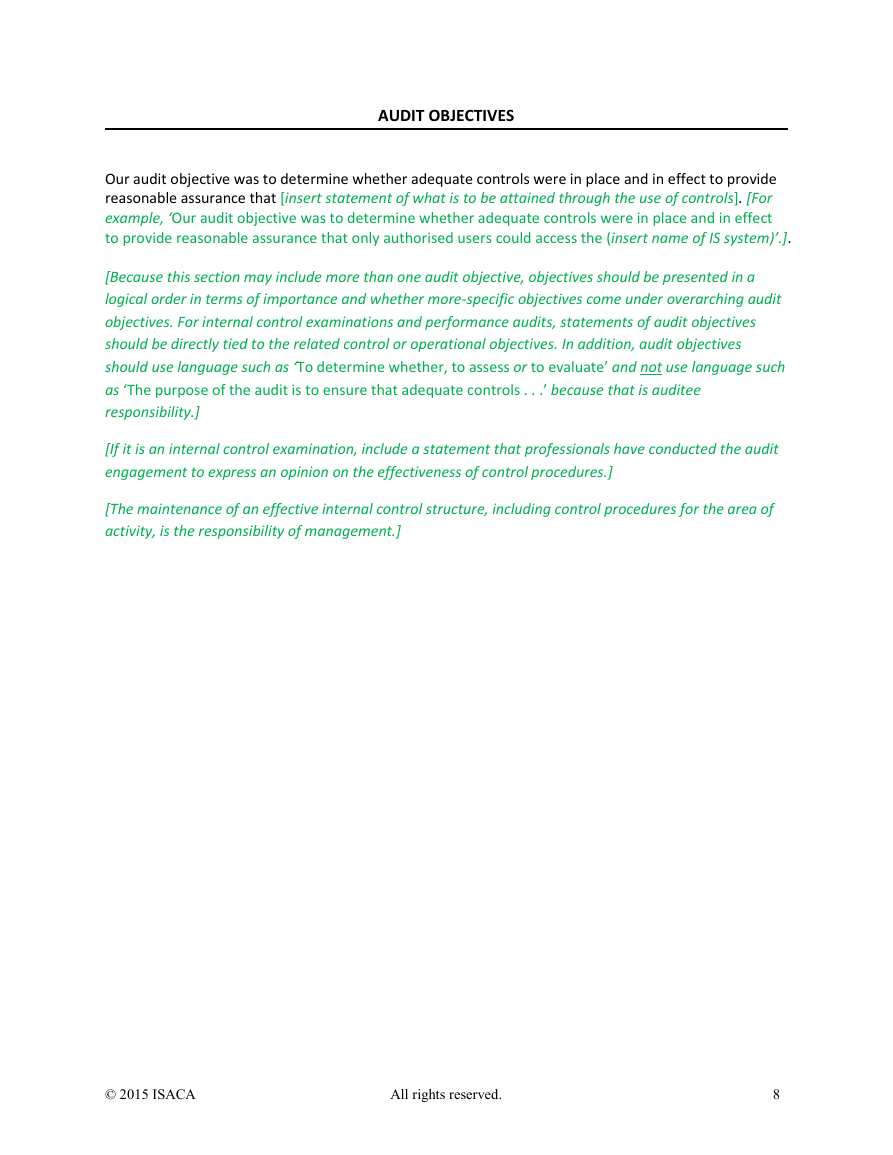








 2023年江西萍乡中考道德与法治真题及答案.doc
2023年江西萍乡中考道德与法治真题及答案.doc 2012年重庆南川中考生物真题及答案.doc
2012年重庆南川中考生物真题及答案.doc 2013年江西师范大学地理学综合及文艺理论基础考研真题.doc
2013年江西师范大学地理学综合及文艺理论基础考研真题.doc 2020年四川甘孜小升初语文真题及答案I卷.doc
2020年四川甘孜小升初语文真题及答案I卷.doc 2020年注册岩土工程师专业基础考试真题及答案.doc
2020年注册岩土工程师专业基础考试真题及答案.doc 2023-2024学年福建省厦门市九年级上学期数学月考试题及答案.doc
2023-2024学年福建省厦门市九年级上学期数学月考试题及答案.doc 2021-2022学年辽宁省沈阳市大东区九年级上学期语文期末试题及答案.doc
2021-2022学年辽宁省沈阳市大东区九年级上学期语文期末试题及答案.doc 2022-2023学年北京东城区初三第一学期物理期末试卷及答案.doc
2022-2023学年北京东城区初三第一学期物理期末试卷及答案.doc 2018上半年江西教师资格初中地理学科知识与教学能力真题及答案.doc
2018上半年江西教师资格初中地理学科知识与教学能力真题及答案.doc 2012年河北国家公务员申论考试真题及答案-省级.doc
2012年河北国家公务员申论考试真题及答案-省级.doc 2020-2021学年江苏省扬州市江都区邵樊片九年级上学期数学第一次质量检测试题及答案.doc
2020-2021学年江苏省扬州市江都区邵樊片九年级上学期数学第一次质量检测试题及答案.doc 2022下半年黑龙江教师资格证中学综合素质真题及答案.doc
2022下半年黑龙江教师资格证中学综合素质真题及答案.doc